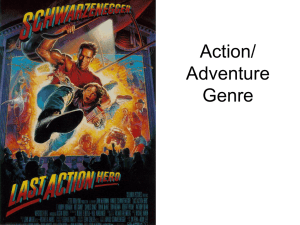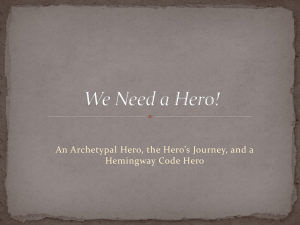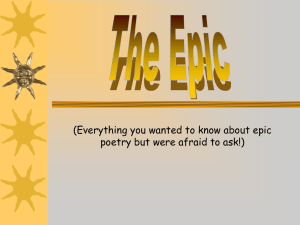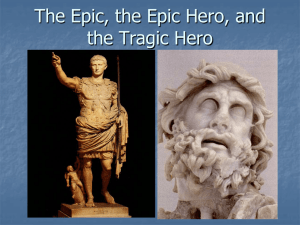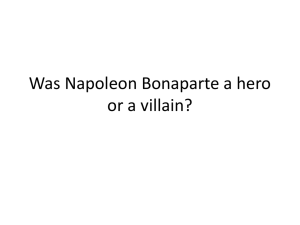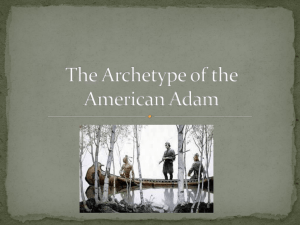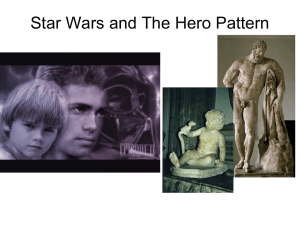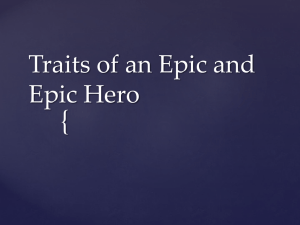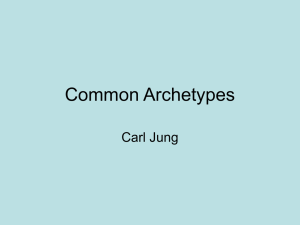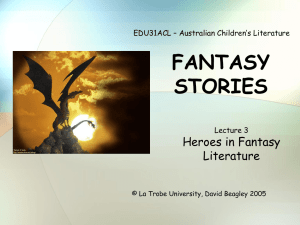Archetypes
advertisement
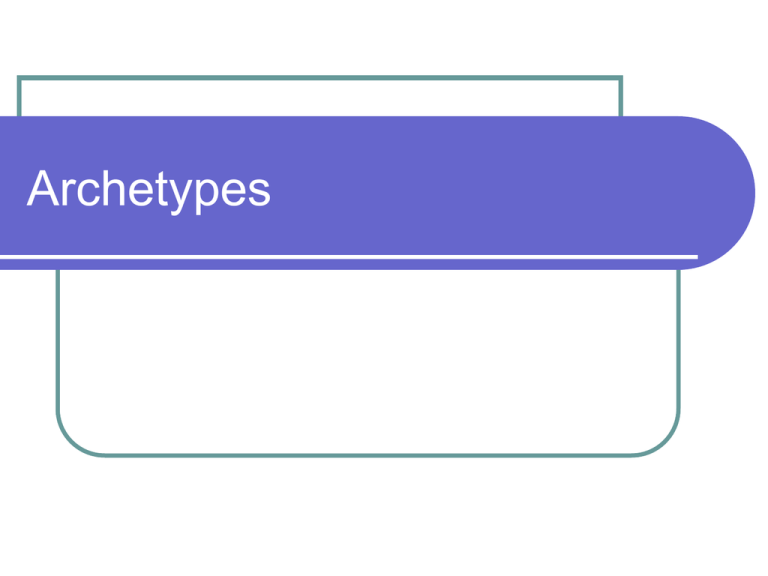
Archetypes What is an archetype? Psychologist Carl Jung and scholar Joseph Campbell “propagated” the concept of archetypes but did not create it. They both recognized the recurring pattern of character types, symbols, relationships, and situations in stories across time periods. related terms= “motif” in mythological work “categories of imagination” in religion Jung= “collective unconscious” as the residual mind of a group of people Definition Archetypes are common character types, symbols and relationships that appear often in stories modern and ancient. The concept of archetypes is an indispensable tool for understanding the purpose or function of characters in a story. Definition cont. They are like "masks" that characters (including the hero) wear at different points of the story. There are many types, but we will focus on the following broad ones: Hero Mentor Herald/Harbinger Threshold Guardian Shape shifter Trickster/Fool Shadow 7 Types of Hero Willing Unwilling Cynical Anti-Hero Tragic Group-Oriented Catalyst Lone The Hero: 7 types Willing Hero This is a hero who knows he or she is a hero, and embraces this role. Examples: King Arthur, Hercules The Hero: 7 types Unwilling Hero: This is a “normal” person who is thrust into a situation in which he or she must become a hero. The Unwilling Hero usually turns out to be very brave, wise, and lucky. Examples: Shrek, Neo from The Matrix, Frodo Baggins, David in Montana 1948 The Hero: 7 types Cynical Anti-Hero Usually a “bad boy” (or girl) type, who lives on outskirts of society and is an outsider, but has a good heart. Examples: Han Solo, Huckleberry Finn, Robin Hood, Holden Caulfield, John McClain in Die Hard The Hero: 7 types Tragic Hero A great person who has one tragic flaw which ultimately brings about his or her downfall. This kind of hero makes the audience feel pity for him or her. Examples: Hamlet, Darth Vader, Oedipus, Othello The Hero: 7 types Group-Oriented Hero This is a hero whose main function is to lead some sort of group to victory against the villain. This kind of hero can be a willing or unwilling hero as well. Examples: William Wallace from Braveheart, Aragorn from Lord of the Rings, Morpheus The Hero: 7 types Catalyst Hero This kind of hero is his or her own mentor, and his/her personality changes very little during the journey. Instead, the Catalyst Hero changes everything around him or her, or might change appearances him- or herself. The mentor for a Catalyst Hero is not external (like Yoda), but his or her internal code of beliefs. Examples: Superman, Spiderman, most comic book heroes, most characters Clint Eastwood plays, The Punisher The Hero: 7 types Lone Hero Like the Anti-Hero, also usually an outsider. This hero works alone, and may be mysterious. Examples: Indiana Jones, Xena, most American West cowboys Archetypes We know them when we see them without even realizing that we know them. Archetypes are Identifiable Consistent Powerful Innate (from within) Archetypes Never confuse archetypes with stereotypes. Stereotypes are Misguided Erratic Weak Archetypes in Heroic Journeys The Hero: GOOD The main character but NOT always admirable. (Not always saving puppies from burning buildings) audience identifies with him/her willing to sacrifice on behalf of others. Examples: David in Montana, Hamlet in Hamlet, Frodo in LOR, many others Archetypes in Heroic Journeys The Mentor: GOOD The wise advisor/teacher to the Hero. Has two responsibilities: teaching the hero life lessons, and giving gifts (often a magical weapon) to the hero. Often the Mentor is a wise older man or woman Examples: Yoda, Morpheus (Matrix), Splinter, Cinderella’s fairy godmother Archetypes in Heroic Journeys The Shadow: In direct conflict with the Hero. EVIL Represents darkness--the Dark Side. Could also represent the fears of society. Could be a person (villain) or an idea (racism). Could be external (outside the Hero, like a villain), or internal (inside the hero, like a tragic flaw). Examples: Wicked Witch in Wizard of Oz, Claudius in Hamlet, Iago in Othello, also Hamlet’s indeciciveness (internal), Othello’s jealousy, Racism (idea), Procrastination (internal). Archetypes in Heroic Journeys The Threshold Guardian: EVIL obstacle in the hero’s way. Often an evil henchman of the Shadow. Isn’t always a character—could be mountain, bad weather, bad luck etc. tests the hero’s skills/willingness to continue Can always be overcome by the Hero, and may even be turned into the Hero’s ally Examples: The mountain, orcs, Gollum, in LOR, Flying monkeys in Wizard of Oz Archetypes in Heroic Journeys The Herald or Harbinger: GOOD or EVIL A messenger who gives the Hero new information. Issues challenges Announces the coming of a significant change. Influences the hero to start the journey. Examples: The messenger in Cinderella, Hagrid in Harry Potter Archetypes in Heroic Journeys The Trickster: GOOD or EVIL A crazy or comic character—adds comedy even in a serious story. Creates mischief just for the sake of mischief, even if it causes trouble for the Hero. Often a sidekick of Hero or Villain. Examples: The mice in Cinderella, Rafiki in Lion King, Dobby in Harry Potter, Timon and Pumbaa in The Lion King Archetypes in Heroic Journeys ???????????? The Shapeshifter Mysterious, alliances are unclear—Sometimes actually changes shapes (the love interest?) The Hero often wonders: “Is he/she on my side or not?” We find out at the end of the story Lures the Hero on to his/her doom or reward Examples: Sauruman and Gollum in LOR, Ursula in Little Mermaid, Prof. Snape in Harry Potter, Aladdin As you watch, please fill out the archetype chart VERY thoroughly. Beware of pop quiz! When we are done, you will use what you learned and apply it to your novel. When we are done watching and reviewing archetypes in this film, you will complete page 2 of your packet VERY thoroughly for your novel. To get at least a D, this must be filled out to my expectations. More is better! Absent yesterday? You need to see me for your one-pager. You have to complete it for me in class. You will do this when we are done with the notes. Syllabus due Friday or Monday after spring break. I need movie selections from those who didn’t turn one in. Please be specific about WHICH version if you are picking a film from a series. Books must be done by the time you return from spring break.
